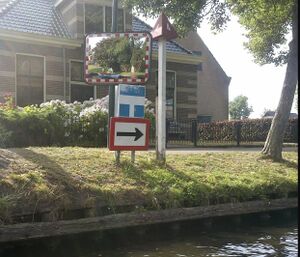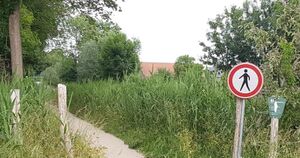Zh-hans:Key:oneway
 |
| 说明 |
|---|
| 车辆只能在单行线上沿一个方向行驶。 |
| 组: Restrictions |
| 用于这些元素 |
| 已记载的值: 5 |
| 常用组合 |
|
| 状态:实际使用 |
| 此标签的工具 |
oneway标签用于表示道路和适用于交通工具的其他线性特征为单行线。这意味着标记为此标签的道路只能被特定单向的交通工具使用。请注意,一条道路的终点处有禁行标志,或道路中的某处有禁行标志,并不一定意味着整条道路都为单行线。请注意道路上的标识以正确标注。
查看access=*了解更多细节。
如何绘图
通常的使用方法
标记一条道路或其他线为单行线,只需要简单地加上一个oneway=*标签。
请注意,oneway=*被定义为在地图中线的方向关系。查看识别线的方向的教程以了解如何在主要的OSM编辑器中识别一条线的方向。
如果单行方向与线的方向相反,常用的解决方案是把线的方向反转(在编辑器中的"reverse way"),然后再标记oneway=yes。在极度罕见的情况下,线的方向可能无法被改变,你可以使用oneway=-1代替。
如果道路只在部分路段单行,你需要将道路分割成几段再进行编辑。
默认的单行限制
一些特殊的标签或标签组合(如 junction=roundabout,highway=motorway以及可能存在的其他标签)默认了oneway=yes。因此oneway=*是可选的。如果一个标签默认了oneway=*,这可以在标签页面的默认标签中找到。除了提到的标签外,标签一般不默认oneway=yes,但不同编辑器可能以不同的方式处理。
oneway = no
oneway=no是用于确保一条街道不是单行线。这个值可用于避免绘图错误,如在多为单行街道的地区。这个值也可用于更改默认的标签。
子标签及例外
子标签可以标记车辆类型以表示例外,如标记一条电动车可以双方向行驶的单行线可使用oneway:moped=no。同理,自行车可标记oneway:bicycle=no。cycleway=opposite/opposite_lane/opposite_track可能被另外用于阐明自行车基础设施并增强兼容性。查看自行车以获取更多示例。查看access标签以了解其他可能的子标签。
时间变化限制
如果一条单行线会在特定时间变换方向,可以标记oneway=reversible并伴随合适的单行限制条件(详见conditional restrictions)。如果方向变换较频繁,标记oneway=alternating会更加合适。
物理分隔带
从理论上说,有物理分隔带的双向道路,应使用两条单行线来表示。若道路无物理分隔带,则使用单条道路表示。但从我国法律法规的角度来看,用实线分隔的双向道路也应使用两条单行线表示。
水路

Legal oneway restrictions for a mandatory direction of travel for boats on 水路也可以被标记为单向,for instance when signposted with a seamark or when this is part of legislation。水流方向通常被路径方向定义。当遇到有两个水流方向的地区的特殊案例时,请考虑与oneway=不同的标签,毕竟oneway=描述了法律意义上的通行方向而不是物理意义上的水流方向。
flow_direction=both曾被用于自然水路及管道以标记它们的流向可以为两个方向中的任意一个。
数据编辑
值
oneway=yes(不建议的值:true,1)oneway=no(不建议的值:false,0)oneway=-1(不建议的值:reverse)oneway=reversible- 很少但规律地在两个方向上变化的道路。这个标签可以在如Zh-hans:Conditional restrictions页面上解释的情况使用。oneway=alternating- 经常并规律地在两个方向上变化的道路。
该标签的其他值是未定义且不被建议使用的。请不要使用不建议使用的值以避免编辑错误。
仅在路径方向无法被倒转的情况下使用oneway=-1!!!
关于导航
oneway=*可以解释为通常的系统(仅为了导航),如下:
单向人行道路的标记

highway=path + oneway=yes + foot=yes + bicycle=no + ski=no + snowmobile=noThis assumes that oneway restrictions do not apply to pedestrians. This in in line with the meaning of common one-way traffic signs, such as sign C, 1a in the Vienna Convention on Road Signs and Signals ("entry is prohibited for all vehicles").
Note that even on a formal highway=footway (with a "footway" traffic sign that in general means that vehicles may not enter, such as D, 5) some vehicles may still enter; for instance when certain types of vehicles (such as bicycles) or certain groups of road users (such as destination traffic) have been exempt from this prohibition by an additional panel. Even in such cases oneway=* may not apply to pedestrians but only to vehicles.
虽然不寻常,但在某些国家/地区,人行道 (path, footway, track) 上的单向是可能的。虽然它有时用有争议的标签表示: oneway:foot=* 。有人认为标签 foot:backward=no 应该是首选,因为它不会受到前者的问题的影响。 In the past highway=path + oneway=yes was used by some mappers to mark that pedestrians may move only in one direction, these situations should be corrected, as oneway in OSM only applies to vehicles. Furthermore a highway=path may be open to others road users such as cyclists.
并非所有当前的使用都反映了上述理论。例如,在 2021 年末 highway=path+oneway=* 用于 32000 个(总共 72000 个)对象, oneway:foot=yes 用于 550 个 (共有 2200 个 oneway:foot=* 对象,其中大多数用作 "oneway=yes+oneway:foot=no") and foot:backward=no 用于 110 个 (总共 260个) 对象表明一些mapper认为 oneway=* 适用于各种移动方式,包括走路。 另一方面,有大量的单向街道仅标记为 oneway=yes ,但对于行人来说是双向的。数据使用者 could follow the vehicle-only theory in most cases but pay special attention and possibly deviate from that theory if oneway:foot=* is present or if oneway=* is set on a footway. 当然,数据使用者可能总是决定以他们认为合适的方式解释标签。

Cases of oneway pedestrian traffic includes some hiking trails - some permanently, some during the high season crowding, border crossing, exit-only passages and more. Mandatory oneway traffic for pedestrians also has been used as a measure for social distancing against COVID-19.
特定国家的影响
下表列出了正确解释单向标签所需的国家特定信息。
| 国家 | 单向标签在特定国家/地区的影响 |
|---|---|
| 荷兰 | Oneway restrictions apply not just to vehicles, but to "voertuigen, ruiters en geleiders van rij- of trekdieren of vee".[1] In OSM context, this e.g. means oneway=yes implies not just vehicle:backward=no but also horse:backward=no (unless oneway:horse=no).
|
| 英国 | Oneway restrictions also apply to horse riders.[2] In OSM context, this e.g. means oneway=yes implies not just vehicle:backward=no but also horse:backward=no (unless oneway:horse=no).
|
可能的标记错误
查看更多
access=*- 一般的通行限制标签- 默认oneway=yes标签的集合
- 拉取请求以考虑在默认地图样式中的默认单向性
foot:backward=no- 通用的单向人行道路标签oneway:foot=*- 对人行道路使用oneway